Maternity Care Models in Australia: Public Health & Outcomes
VerifiedAdded on 2023/06/11
|11
|3007
|324
Essay
AI Summary
This essay provides an overview of the four main models of maternity care available to women in Australia: Private Maternity Care, Combined Maternity Care, Team Midwifery Care, and Shared Maternity Care. It evaluates these models in relation to the principles of public health, particularly focusing on the relationship between continuity of care and/or carer, and maternal and neonatal outcomes. The essay highlights the significance of midwives in public health, the benefits of midwifery-led care, and the importance of a skilled and multidisciplinary workforce in ensuring high-quality maternal and newborn care. It also touches upon risk evaluation, management in maternity care, and the need for continuous improvement in the organization of maternity services to meet the evolving needs of women and their babies.
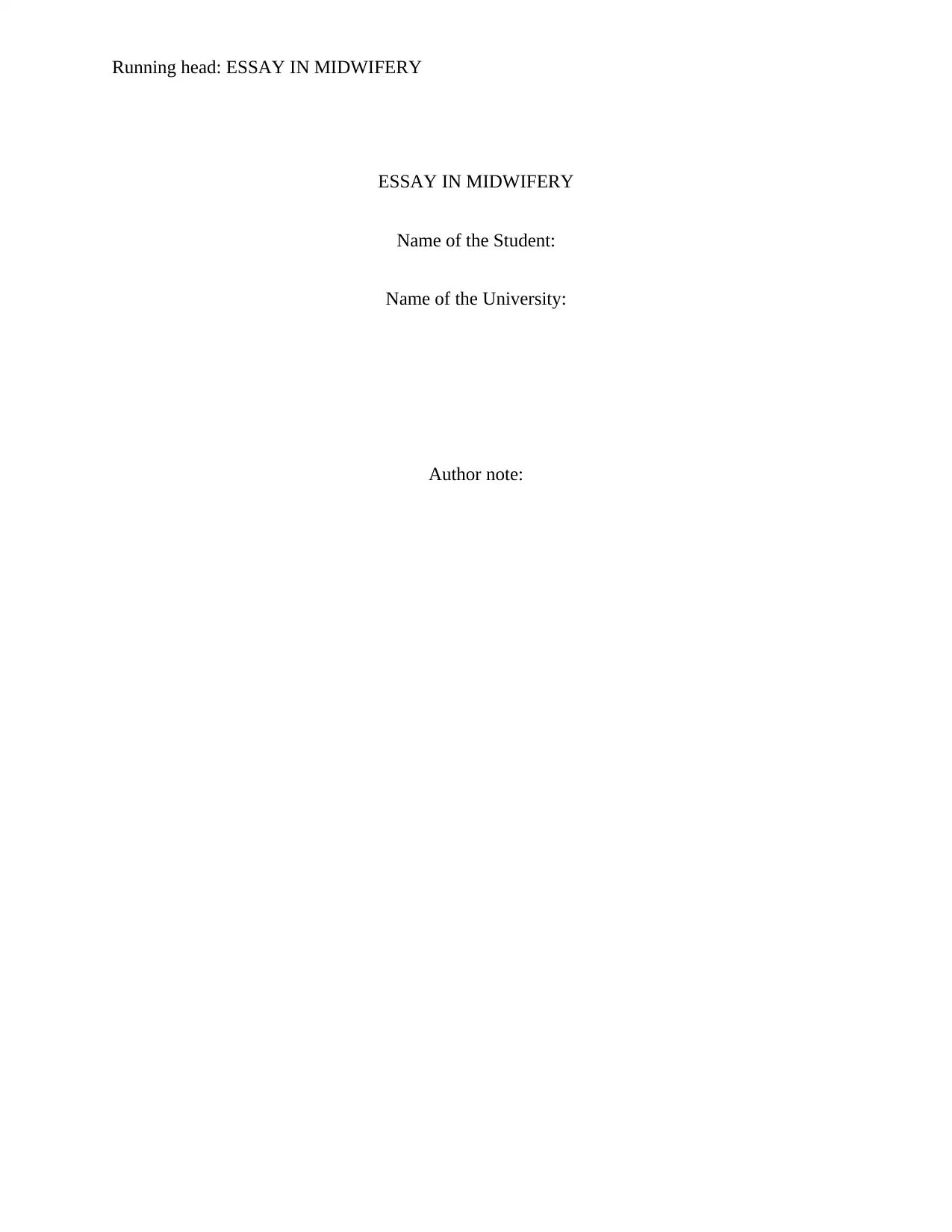
Running head: ESSAY IN MIDWIFERY
ESSAY IN MIDWIFERY
Name of the Student:
Name of the University:
Author note:
ESSAY IN MIDWIFERY
Name of the Student:
Name of the University:
Author note:
Paraphrase This Document
Need a fresh take? Get an instant paraphrase of this document with our AI Paraphraser
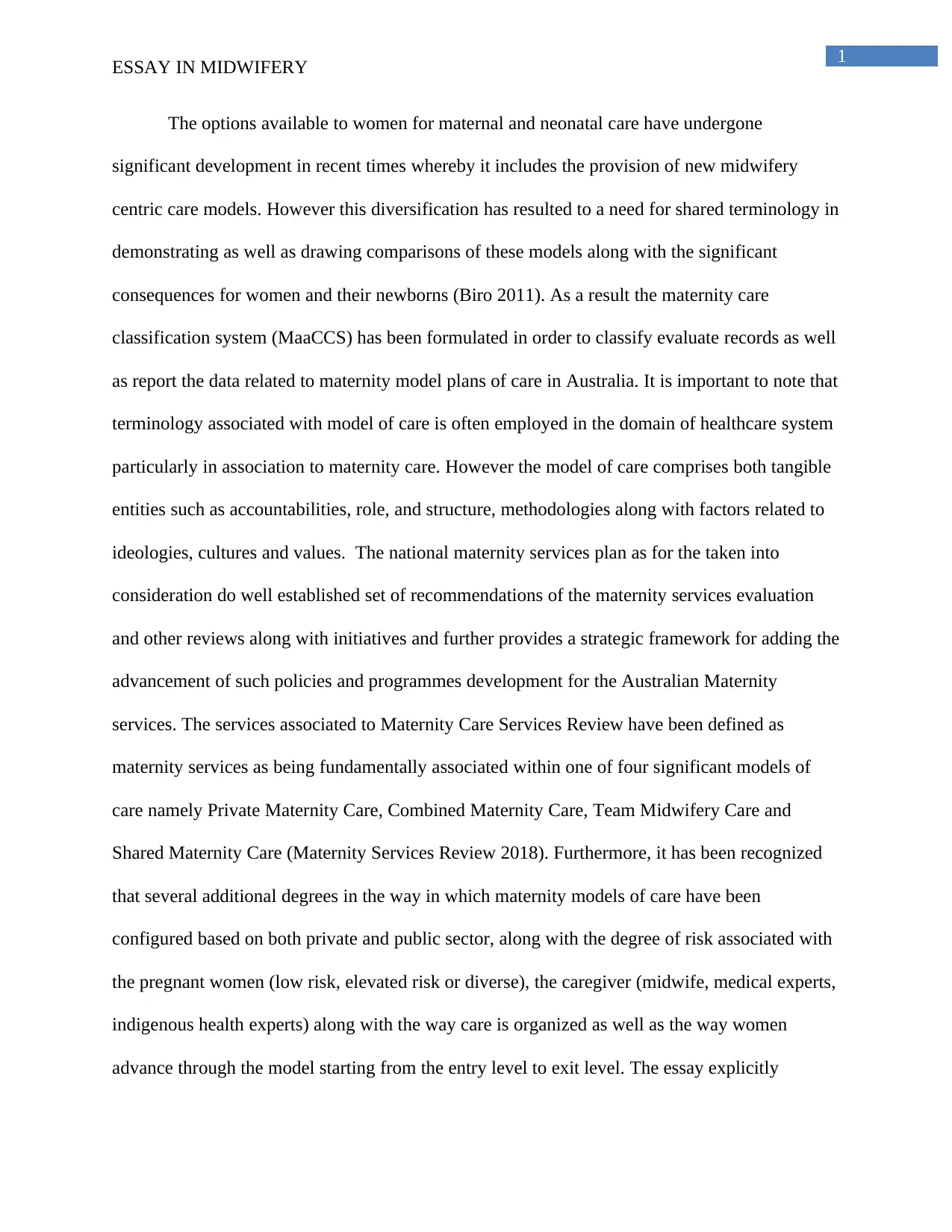
1
ESSAY IN MIDWIFERY
The options available to women for maternal and neonatal care have undergone
significant development in recent times whereby it includes the provision of new midwifery
centric care models. However this diversification has resulted to a need for shared terminology in
demonstrating as well as drawing comparisons of these models along with the significant
consequences for women and their newborns (Biro 2011). As a result the maternity care
classification system (MaaCCS) has been formulated in order to classify evaluate records as well
as report the data related to maternity model plans of care in Australia. It is important to note that
terminology associated with model of care is often employed in the domain of healthcare system
particularly in association to maternity care. However the model of care comprises both tangible
entities such as accountabilities, role, and structure, methodologies along with factors related to
ideologies, cultures and values. The national maternity services plan as for the taken into
consideration do well established set of recommendations of the maternity services evaluation
and other reviews along with initiatives and further provides a strategic framework for adding the
advancement of such policies and programmes development for the Australian Maternity
services. The services associated to Maternity Care Services Review have been defined as
maternity services as being fundamentally associated within one of four significant models of
care namely Private Maternity Care, Combined Maternity Care, Team Midwifery Care and
Shared Maternity Care (Maternity Services Review 2018). Furthermore, it has been recognized
that several additional degrees in the way in which maternity models of care have been
configured based on both private and public sector, along with the degree of risk associated with
the pregnant women (low risk, elevated risk or diverse), the caregiver (midwife, medical experts,
indigenous health experts) along with the way care is organized as well as the way women
advance through the model starting from the entry level to exit level. The essay explicitly
ESSAY IN MIDWIFERY
The options available to women for maternal and neonatal care have undergone
significant development in recent times whereby it includes the provision of new midwifery
centric care models. However this diversification has resulted to a need for shared terminology in
demonstrating as well as drawing comparisons of these models along with the significant
consequences for women and their newborns (Biro 2011). As a result the maternity care
classification system (MaaCCS) has been formulated in order to classify evaluate records as well
as report the data related to maternity model plans of care in Australia. It is important to note that
terminology associated with model of care is often employed in the domain of healthcare system
particularly in association to maternity care. However the model of care comprises both tangible
entities such as accountabilities, role, and structure, methodologies along with factors related to
ideologies, cultures and values. The national maternity services plan as for the taken into
consideration do well established set of recommendations of the maternity services evaluation
and other reviews along with initiatives and further provides a strategic framework for adding the
advancement of such policies and programmes development for the Australian Maternity
services. The services associated to Maternity Care Services Review have been defined as
maternity services as being fundamentally associated within one of four significant models of
care namely Private Maternity Care, Combined Maternity Care, Team Midwifery Care and
Shared Maternity Care (Maternity Services Review 2018). Furthermore, it has been recognized
that several additional degrees in the way in which maternity models of care have been
configured based on both private and public sector, along with the degree of risk associated with
the pregnant women (low risk, elevated risk or diverse), the caregiver (midwife, medical experts,
indigenous health experts) along with the way care is organized as well as the way women
advance through the model starting from the entry level to exit level. The essay explicitly
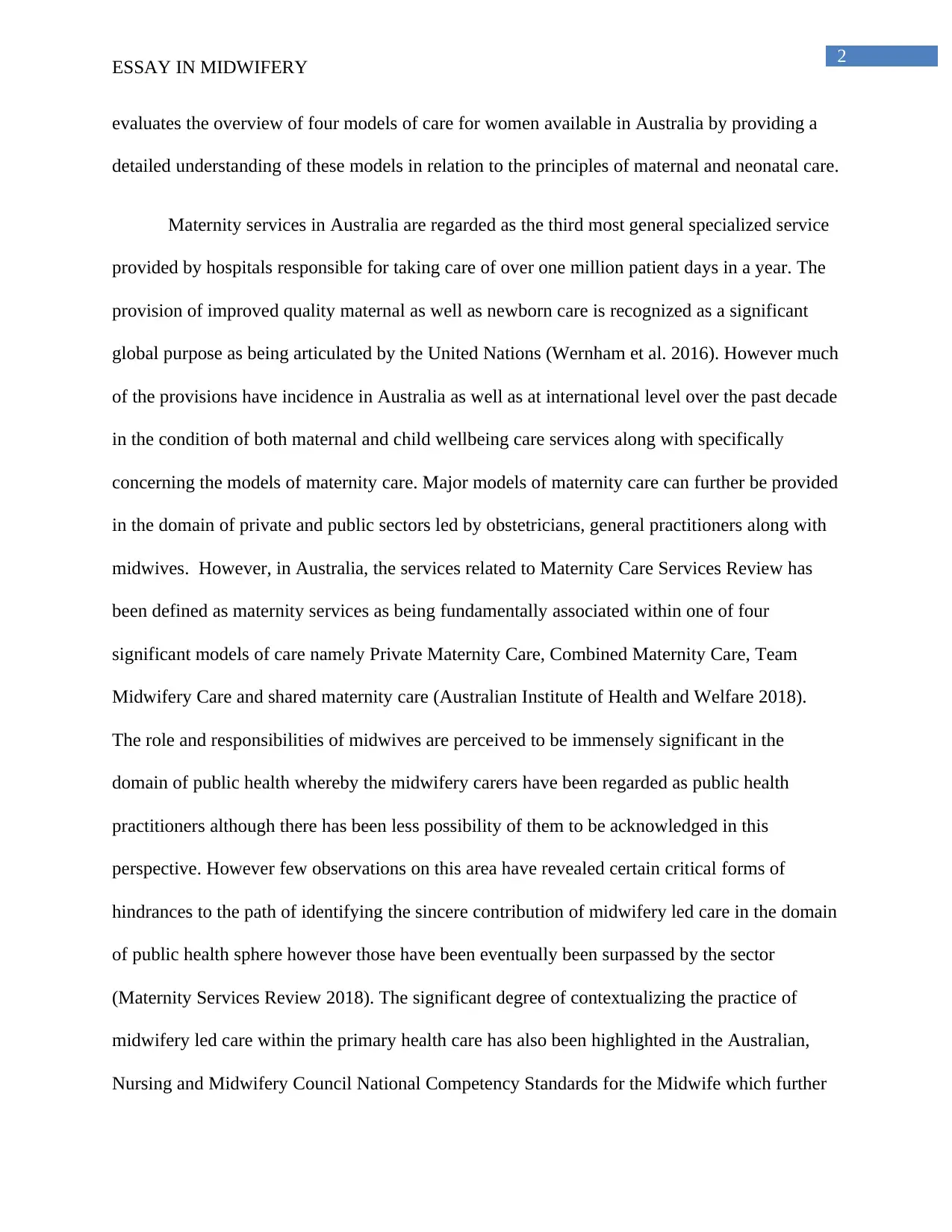
2
ESSAY IN MIDWIFERY
evaluates the overview of four models of care for women available in Australia by providing a
detailed understanding of these models in relation to the principles of maternal and neonatal care.
Maternity services in Australia are regarded as the third most general specialized service
provided by hospitals responsible for taking care of over one million patient days in a year. The
provision of improved quality maternal as well as newborn care is recognized as a significant
global purpose as being articulated by the United Nations (Wernham et al. 2016). However much
of the provisions have incidence in Australia as well as at international level over the past decade
in the condition of both maternal and child wellbeing care services along with specifically
concerning the models of maternity care. Major models of maternity care can further be provided
in the domain of private and public sectors led by obstetricians, general practitioners along with
midwives. However, in Australia, the services related to Maternity Care Services Review has
been defined as maternity services as being fundamentally associated within one of four
significant models of care namely Private Maternity Care, Combined Maternity Care, Team
Midwifery Care and shared maternity care (Australian Institute of Health and Welfare 2018).
The role and responsibilities of midwives are perceived to be immensely significant in the
domain of public health whereby the midwifery carers have been regarded as public health
practitioners although there has been less possibility of them to be acknowledged in this
perspective. However few observations on this area have revealed certain critical forms of
hindrances to the path of identifying the sincere contribution of midwifery led care in the domain
of public health sphere however those have been eventually been surpassed by the sector
(Maternity Services Review 2018). The significant degree of contextualizing the practice of
midwifery led care within the primary health care has also been highlighted in the Australian,
Nursing and Midwifery Council National Competency Standards for the Midwife which further
ESSAY IN MIDWIFERY
evaluates the overview of four models of care for women available in Australia by providing a
detailed understanding of these models in relation to the principles of maternal and neonatal care.
Maternity services in Australia are regarded as the third most general specialized service
provided by hospitals responsible for taking care of over one million patient days in a year. The
provision of improved quality maternal as well as newborn care is recognized as a significant
global purpose as being articulated by the United Nations (Wernham et al. 2016). However much
of the provisions have incidence in Australia as well as at international level over the past decade
in the condition of both maternal and child wellbeing care services along with specifically
concerning the models of maternity care. Major models of maternity care can further be provided
in the domain of private and public sectors led by obstetricians, general practitioners along with
midwives. However, in Australia, the services related to Maternity Care Services Review has
been defined as maternity services as being fundamentally associated within one of four
significant models of care namely Private Maternity Care, Combined Maternity Care, Team
Midwifery Care and shared maternity care (Australian Institute of Health and Welfare 2018).
The role and responsibilities of midwives are perceived to be immensely significant in the
domain of public health whereby the midwifery carers have been regarded as public health
practitioners although there has been less possibility of them to be acknowledged in this
perspective. However few observations on this area have revealed certain critical forms of
hindrances to the path of identifying the sincere contribution of midwifery led care in the domain
of public health sphere however those have been eventually been surpassed by the sector
(Maternity Services Review 2018). The significant degree of contextualizing the practice of
midwifery led care within the primary health care has also been highlighted in the Australian,
Nursing and Midwifery Council National Competency Standards for the Midwife which further
⊘ This is a preview!⊘
Do you want full access?
Subscribe today to unlock all pages.

Trusted by 1+ million students worldwide
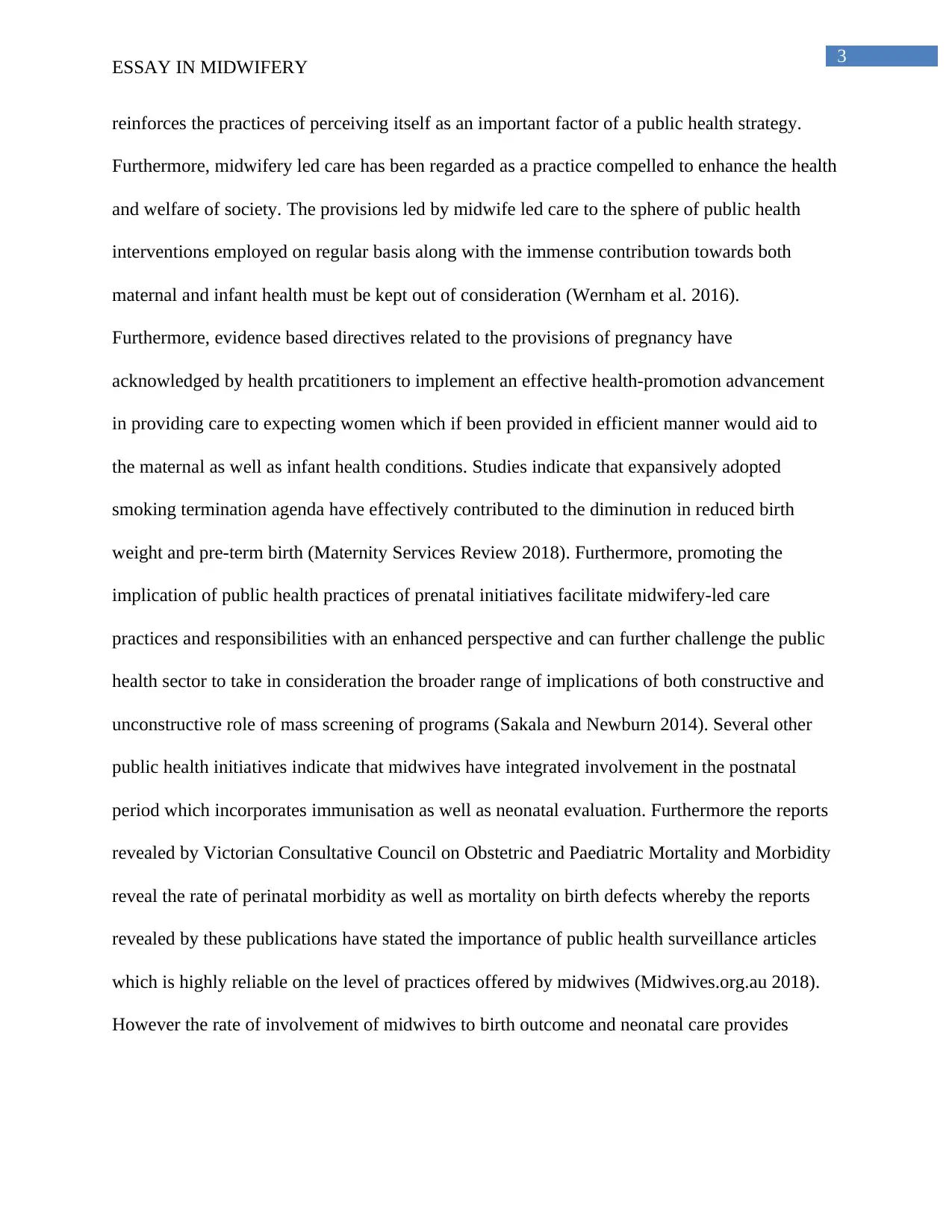
3
ESSAY IN MIDWIFERY
reinforces the practices of perceiving itself as an important factor of a public health strategy.
Furthermore, midwifery led care has been regarded as a practice compelled to enhance the health
and welfare of society. The provisions led by midwife led care to the sphere of public health
interventions employed on regular basis along with the immense contribution towards both
maternal and infant health must be kept out of consideration (Wernham et al. 2016).
Furthermore, evidence based directives related to the provisions of pregnancy have
acknowledged by health prcatitioners to implement an effective health-promotion advancement
in providing care to expecting women which if been provided in efficient manner would aid to
the maternal as well as infant health conditions. Studies indicate that expansively adopted
smoking termination agenda have effectively contributed to the diminution in reduced birth
weight and pre-term birth (Maternity Services Review 2018). Furthermore, promoting the
implication of public health practices of prenatal initiatives facilitate midwifery-led care
practices and responsibilities with an enhanced perspective and can further challenge the public
health sector to take in consideration the broader range of implications of both constructive and
unconstructive role of mass screening of programs (Sakala and Newburn 2014). Several other
public health initiatives indicate that midwives have integrated involvement in the postnatal
period which incorporates immunisation as well as neonatal evaluation. Furthermore the reports
revealed by Victorian Consultative Council on Obstetric and Paediatric Mortality and Morbidity
reveal the rate of perinatal morbidity as well as mortality on birth defects whereby the reports
revealed by these publications have stated the importance of public health surveillance articles
which is highly reliable on the level of practices offered by midwives (Midwives.org.au 2018).
However the rate of involvement of midwives to birth outcome and neonatal care provides
ESSAY IN MIDWIFERY
reinforces the practices of perceiving itself as an important factor of a public health strategy.
Furthermore, midwifery led care has been regarded as a practice compelled to enhance the health
and welfare of society. The provisions led by midwife led care to the sphere of public health
interventions employed on regular basis along with the immense contribution towards both
maternal and infant health must be kept out of consideration (Wernham et al. 2016).
Furthermore, evidence based directives related to the provisions of pregnancy have
acknowledged by health prcatitioners to implement an effective health-promotion advancement
in providing care to expecting women which if been provided in efficient manner would aid to
the maternal as well as infant health conditions. Studies indicate that expansively adopted
smoking termination agenda have effectively contributed to the diminution in reduced birth
weight and pre-term birth (Maternity Services Review 2018). Furthermore, promoting the
implication of public health practices of prenatal initiatives facilitate midwifery-led care
practices and responsibilities with an enhanced perspective and can further challenge the public
health sector to take in consideration the broader range of implications of both constructive and
unconstructive role of mass screening of programs (Sakala and Newburn 2014). Several other
public health initiatives indicate that midwives have integrated involvement in the postnatal
period which incorporates immunisation as well as neonatal evaluation. Furthermore the reports
revealed by Victorian Consultative Council on Obstetric and Paediatric Mortality and Morbidity
reveal the rate of perinatal morbidity as well as mortality on birth defects whereby the reports
revealed by these publications have stated the importance of public health surveillance articles
which is highly reliable on the level of practices offered by midwives (Midwives.org.au 2018).
However the rate of involvement of midwives to birth outcome and neonatal care provides
Paraphrase This Document
Need a fresh take? Get an instant paraphrase of this document with our AI Paraphraser

4
ESSAY IN MIDWIFERY
significant implications on the midwifery role and responsibilities in the domain of public health
(White 2015).
It has been noted, considerable rate of observation has been undertaken into the health
models of maternity care which significantly provide immense constancy in the operations of
midwifery led care. In several cases, the women has been occupying a significant position at the
low degree risk of obstetric dilemmas and complications whereby women from Sydney and
Brisbane has revealed conditions of varied obstetric as well as therapeutic risk conditions and has
not been transmitted out the domains of the model if further menace determinants have been
developed (Symon et al. 2016). Furthermore, it has been recognized that women who have
received services of care by midwife have revealed the potentialities to be exposed more towards
unplanned vaginal birth delivery and further have less chances to have epidural analgesia,
episiotomies or influential delivery. Furthermore, women have posed less potentialities to
undergo a pre-term child delivery and their newborns have low chances of dying (Symon et al.
2016). As a result, women have regarded the mid-wife centric services of care models as
increasingly in relation to high rate of contentment, satisfaction along with the elevating trend
concerning a cost-retaining impact for the midwife centric models, though there have been
noticed a rate of inconsistency in reporting of both such consequences. The midwifery care
model has been evaluated in several cases of non-randomised investigations along with the
increased degree of menace of bias (Bai et al. 2008). Furthermore midwives have been organized
in communities or groups of four and are held accountable for the rate of concern and care
associated to a particular numbers of cases of women during pregnancy period, birth along with
the post partum period (Sakala and Newburn 2014). Women who have received considerable rate
of concern and care have indicated potentiality to have an unprompted onset of labour along with
ESSAY IN MIDWIFERY
significant implications on the midwifery role and responsibilities in the domain of public health
(White 2015).
It has been noted, considerable rate of observation has been undertaken into the health
models of maternity care which significantly provide immense constancy in the operations of
midwifery led care. In several cases, the women has been occupying a significant position at the
low degree risk of obstetric dilemmas and complications whereby women from Sydney and
Brisbane has revealed conditions of varied obstetric as well as therapeutic risk conditions and has
not been transmitted out the domains of the model if further menace determinants have been
developed (Symon et al. 2016). Furthermore, it has been recognized that women who have
received services of care by midwife have revealed the potentialities to be exposed more towards
unplanned vaginal birth delivery and further have less chances to have epidural analgesia,
episiotomies or influential delivery. Furthermore, women have posed less potentialities to
undergo a pre-term child delivery and their newborns have low chances of dying (Symon et al.
2016). As a result, women have regarded the mid-wife centric services of care models as
increasingly in relation to high rate of contentment, satisfaction along with the elevating trend
concerning a cost-retaining impact for the midwife centric models, though there have been
noticed a rate of inconsistency in reporting of both such consequences. The midwifery care
model has been evaluated in several cases of non-randomised investigations along with the
increased degree of menace of bias (Bai et al. 2008). Furthermore midwives have been organized
in communities or groups of four and are held accountable for the rate of concern and care
associated to a particular numbers of cases of women during pregnancy period, birth along with
the post partum period (Sakala and Newburn 2014). Women who have received considerable rate
of concern and care have indicated potentiality to have an unprompted onset of labour along with
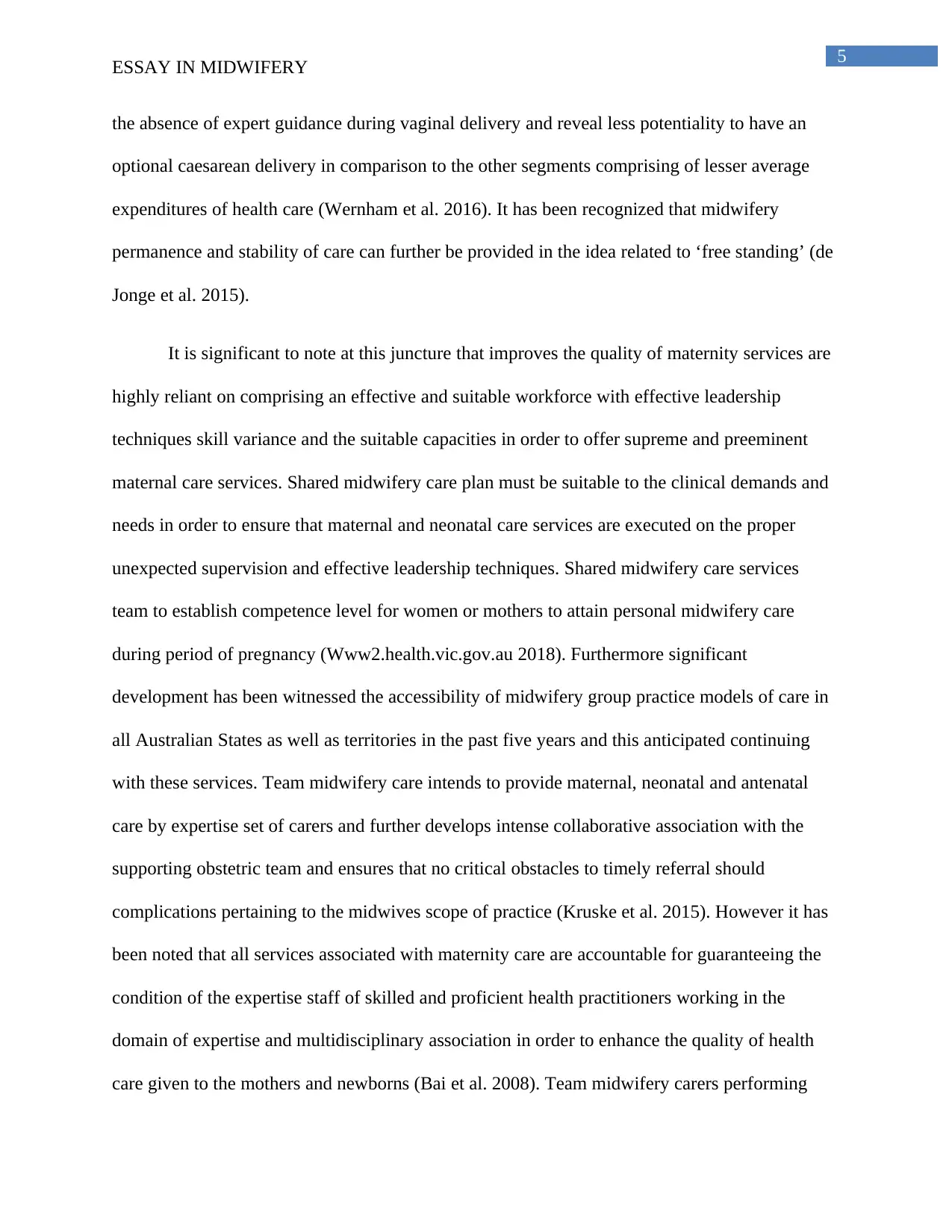
5
ESSAY IN MIDWIFERY
the absence of expert guidance during vaginal delivery and reveal less potentiality to have an
optional caesarean delivery in comparison to the other segments comprising of lesser average
expenditures of health care (Wernham et al. 2016). It has been recognized that midwifery
permanence and stability of care can further be provided in the idea related to ‘free standing’ (de
Jonge et al. 2015).
It is significant to note at this juncture that improves the quality of maternity services are
highly reliant on comprising an effective and suitable workforce with effective leadership
techniques skill variance and the suitable capacities in order to offer supreme and preeminent
maternal care services. Shared midwifery care plan must be suitable to the clinical demands and
needs in order to ensure that maternal and neonatal care services are executed on the proper
unexpected supervision and effective leadership techniques. Shared midwifery care services
team to establish competence level for women or mothers to attain personal midwifery care
during period of pregnancy (Www2.health.vic.gov.au 2018). Furthermore significant
development has been witnessed the accessibility of midwifery group practice models of care in
all Australian States as well as territories in the past five years and this anticipated continuing
with these services. Team midwifery care intends to provide maternal, neonatal and antenatal
care by expertise set of carers and further develops intense collaborative association with the
supporting obstetric team and ensures that no critical obstacles to timely referral should
complications pertaining to the midwives scope of practice (Kruske et al. 2015). However it has
been noted that all services associated with maternity care are accountable for guaranteeing the
condition of the expertise staff of skilled and proficient health practitioners working in the
domain of expertise and multidisciplinary association in order to enhance the quality of health
care given to the mothers and newborns (Bai et al. 2008). Team midwifery carers performing
ESSAY IN MIDWIFERY
the absence of expert guidance during vaginal delivery and reveal less potentiality to have an
optional caesarean delivery in comparison to the other segments comprising of lesser average
expenditures of health care (Wernham et al. 2016). It has been recognized that midwifery
permanence and stability of care can further be provided in the idea related to ‘free standing’ (de
Jonge et al. 2015).
It is significant to note at this juncture that improves the quality of maternity services are
highly reliant on comprising an effective and suitable workforce with effective leadership
techniques skill variance and the suitable capacities in order to offer supreme and preeminent
maternal care services. Shared midwifery care plan must be suitable to the clinical demands and
needs in order to ensure that maternal and neonatal care services are executed on the proper
unexpected supervision and effective leadership techniques. Shared midwifery care services
team to establish competence level for women or mothers to attain personal midwifery care
during period of pregnancy (Www2.health.vic.gov.au 2018). Furthermore significant
development has been witnessed the accessibility of midwifery group practice models of care in
all Australian States as well as territories in the past five years and this anticipated continuing
with these services. Team midwifery care intends to provide maternal, neonatal and antenatal
care by expertise set of carers and further develops intense collaborative association with the
supporting obstetric team and ensures that no critical obstacles to timely referral should
complications pertaining to the midwives scope of practice (Kruske et al. 2015). However it has
been noted that all services associated with maternity care are accountable for guaranteeing the
condition of the expertise staff of skilled and proficient health practitioners working in the
domain of expertise and multidisciplinary association in order to enhance the quality of health
care given to the mothers and newborns (Bai et al. 2008). Team midwifery carers performing
⊘ This is a preview!⊘
Do you want full access?
Subscribe today to unlock all pages.

Trusted by 1+ million students worldwide

6
ESSAY IN MIDWIFERY
their services with women or mothers in the maternal period or pre pregnancy period have been
considered as immensely competent in advising recommending or referring women who would
aid from improved specialised or expertise services (White 2015). Furthermore team midwifery
carers provide active participation in the program of continuing professional development which
incorporates only recognition and appropriate management or referral father of women suffering
from obstetric or other forms of complications such as perinatal mental health (Maternity
Services Review 2018). However it is important to note that midwives team must further be
competent enough to identify the limitations of capabilities and work in accordance to those set
limitations. Furthermore this segment of carers should have appropriate level of competence in
order to elicit relevant knowledge and information insensitive manner and further recognise
critical conditions occurring simultaneously or an anticipation of potential severe past psychiatric
record (Bai et al. 2008). Studies have revealed that all health professionals have an explicit
understanding of concepts related to risk evaluation as well as management in order to enhance
the level of quality of care and wellbeing towards the mothers as well as babies by condensing
the rate preventable undesirable medical incidence (Sakala and Newburn 2014). However at
times of an incident every health unit must adhere to a distinct mechanism in order to supervise
the situation which includes an inquiry, understanding and communication along with the
necessary implementing transitions to the existing procedures training or recruiting levels.
In the process to re-consider the organisation of maternity care several studies have being
conducted with systematic reviews of the perception and experiences women have encountered
related to care provided to mothers along with the relevant implications of that care. It has been
noted that a methodical level transition ranging from the submitted maternal as well as newborn
care have explicitly concentrated on the recognition and management of pathology for the
ESSAY IN MIDWIFERY
their services with women or mothers in the maternal period or pre pregnancy period have been
considered as immensely competent in advising recommending or referring women who would
aid from improved specialised or expertise services (White 2015). Furthermore team midwifery
carers provide active participation in the program of continuing professional development which
incorporates only recognition and appropriate management or referral father of women suffering
from obstetric or other forms of complications such as perinatal mental health (Maternity
Services Review 2018). However it is important to note that midwives team must further be
competent enough to identify the limitations of capabilities and work in accordance to those set
limitations. Furthermore this segment of carers should have appropriate level of competence in
order to elicit relevant knowledge and information insensitive manner and further recognise
critical conditions occurring simultaneously or an anticipation of potential severe past psychiatric
record (Bai et al. 2008). Studies have revealed that all health professionals have an explicit
understanding of concepts related to risk evaluation as well as management in order to enhance
the level of quality of care and wellbeing towards the mothers as well as babies by condensing
the rate preventable undesirable medical incidence (Sakala and Newburn 2014). However at
times of an incident every health unit must adhere to a distinct mechanism in order to supervise
the situation which includes an inquiry, understanding and communication along with the
necessary implementing transitions to the existing procedures training or recruiting levels.
In the process to re-consider the organisation of maternity care several studies have being
conducted with systematic reviews of the perception and experiences women have encountered
related to care provided to mothers along with the relevant implications of that care. It has been
noted that a methodical level transition ranging from the submitted maternal as well as newborn
care have explicitly concentrated on the recognition and management of pathology for the
Paraphrase This Document
Need a fresh take? Get an instant paraphrase of this document with our AI Paraphraser

7
ESSAY IN MIDWIFERY
marginalized section to skills and expertise care intended for the entire section (Sakala and
Newburn 2014). The concept of maternity care further emphasizes on the importance and vitality
of preventive as well as supportive care which reinforces the competence level of the women and
further accomplishes their needs and demands. However the consequential quality associated to
maternal and newborn care agenda has been formulated on the basis of the factors associated
with the degree of care which is of utmost significance to the mothers (Maternity Services
Review 2018). However significant observation on maternity care have indicated that the most
effective maternity and perinatal outcome are achievable if the level of midwifery care is offered
by highly expertise skilled and knowledgeable midwives who perform their role in effective
collaboration and teamwork as part of the interdisciplinary association by for the providing
efficient care across community as well as hospital settings (Biro 2011).
Therefore from the above discussion it can be noted that the role of midwifery led
care has been crucial in the domain associated to health care and maternal as well as neonatal
outcome and is further considered as skilled competent and a passionate care for childbearing
women or newborn infants. Furthermore the comprehensiveness in maternity and neonatal care
plan for the beam evaluated by the role of team advisory practitioners as the initial carer as well
as the condition of preventive care as well as health promotion. Thus it can be stated that
midwife centric care has been associated with enhanced rate of maternal satisfaction and an
effective trend which promotes reduced expenditure of maternal services.
ESSAY IN MIDWIFERY
marginalized section to skills and expertise care intended for the entire section (Sakala and
Newburn 2014). The concept of maternity care further emphasizes on the importance and vitality
of preventive as well as supportive care which reinforces the competence level of the women and
further accomplishes their needs and demands. However the consequential quality associated to
maternal and newborn care agenda has been formulated on the basis of the factors associated
with the degree of care which is of utmost significance to the mothers (Maternity Services
Review 2018). However significant observation on maternity care have indicated that the most
effective maternity and perinatal outcome are achievable if the level of midwifery care is offered
by highly expertise skilled and knowledgeable midwives who perform their role in effective
collaboration and teamwork as part of the interdisciplinary association by for the providing
efficient care across community as well as hospital settings (Biro 2011).
Therefore from the above discussion it can be noted that the role of midwifery led
care has been crucial in the domain associated to health care and maternal as well as neonatal
outcome and is further considered as skilled competent and a passionate care for childbearing
women or newborn infants. Furthermore the comprehensiveness in maternity and neonatal care
plan for the beam evaluated by the role of team advisory practitioners as the initial carer as well
as the condition of preventive care as well as health promotion. Thus it can be stated that
midwife centric care has been associated with enhanced rate of maternal satisfaction and an
effective trend which promotes reduced expenditure of maternal services.

8
ESSAY IN MIDWIFERY
References
Australian Institute of Health and Welfare., 2018. Maternity Model of Care Data Set
Specification national pilot report. Maternity Care Classification System. [online] Canberra:
Australian Institute of Health and Welfare Canberra, pp.4-45. Available at:
https://www.aihw.gov.au/getmedia/3ca9f920-1b65-466e-871c-084c4827a5ae/19300.pdf.aspx?
inline=true [Accessed 12 Jun. 2018].
Bai, J., Gyaneshwar, R. and Bauman, A., 2008. Models of antenatal care and obstetric outcomes
in Sydney South West. Australian and New Zealand Journal of Obstetrics and
Gynaecology, 48(5), pp.454-461.
Biro, M.A., 2011. What has public health got to do with midwifery? Midwives’ role in securing
better health outcomes for mothers and babies. Women and Birth, 24(1), pp.17-23.
de Jonge, A., de Vries, R., Lagro-Janssen, A.L., Declercq, E., Downe, S. and Hutton, E.K., 2015.
The importance of evaluating primary midwifery care for improving the health of women and
infants. Frontiers in medicine, 2, p.17.
Homer, C.S., 2016. Models of maternity care: evidence for midwifery continuity of care. The
Medical Journal of Australia, 205(8), pp.370-374.
Kruske, S., Schultz, T., Eales, S. and Kildea, S., 2015. A retrospective, descriptive study of
maternal and neonatal transfers, and clinical outcomes of a Primary Maternity Unit in rural
Queensland, 2009–2011. Women and Birth, 28(1), pp.30-39.
Maternity Services Review., 2018. Improving Maternity Services in Australia. The Report of the
Maternity Services Review. [online] Australia: Commonwealth of Australia 2009, pp.10-47.
ESSAY IN MIDWIFERY
References
Australian Institute of Health and Welfare., 2018. Maternity Model of Care Data Set
Specification national pilot report. Maternity Care Classification System. [online] Canberra:
Australian Institute of Health and Welfare Canberra, pp.4-45. Available at:
https://www.aihw.gov.au/getmedia/3ca9f920-1b65-466e-871c-084c4827a5ae/19300.pdf.aspx?
inline=true [Accessed 12 Jun. 2018].
Bai, J., Gyaneshwar, R. and Bauman, A., 2008. Models of antenatal care and obstetric outcomes
in Sydney South West. Australian and New Zealand Journal of Obstetrics and
Gynaecology, 48(5), pp.454-461.
Biro, M.A., 2011. What has public health got to do with midwifery? Midwives’ role in securing
better health outcomes for mothers and babies. Women and Birth, 24(1), pp.17-23.
de Jonge, A., de Vries, R., Lagro-Janssen, A.L., Declercq, E., Downe, S. and Hutton, E.K., 2015.
The importance of evaluating primary midwifery care for improving the health of women and
infants. Frontiers in medicine, 2, p.17.
Homer, C.S., 2016. Models of maternity care: evidence for midwifery continuity of care. The
Medical Journal of Australia, 205(8), pp.370-374.
Kruske, S., Schultz, T., Eales, S. and Kildea, S., 2015. A retrospective, descriptive study of
maternal and neonatal transfers, and clinical outcomes of a Primary Maternity Unit in rural
Queensland, 2009–2011. Women and Birth, 28(1), pp.30-39.
Maternity Services Review., 2018. Improving Maternity Services in Australia. The Report of the
Maternity Services Review. [online] Australia: Commonwealth of Australia 2009, pp.10-47.
⊘ This is a preview!⊘
Do you want full access?
Subscribe today to unlock all pages.

Trusted by 1+ million students worldwide
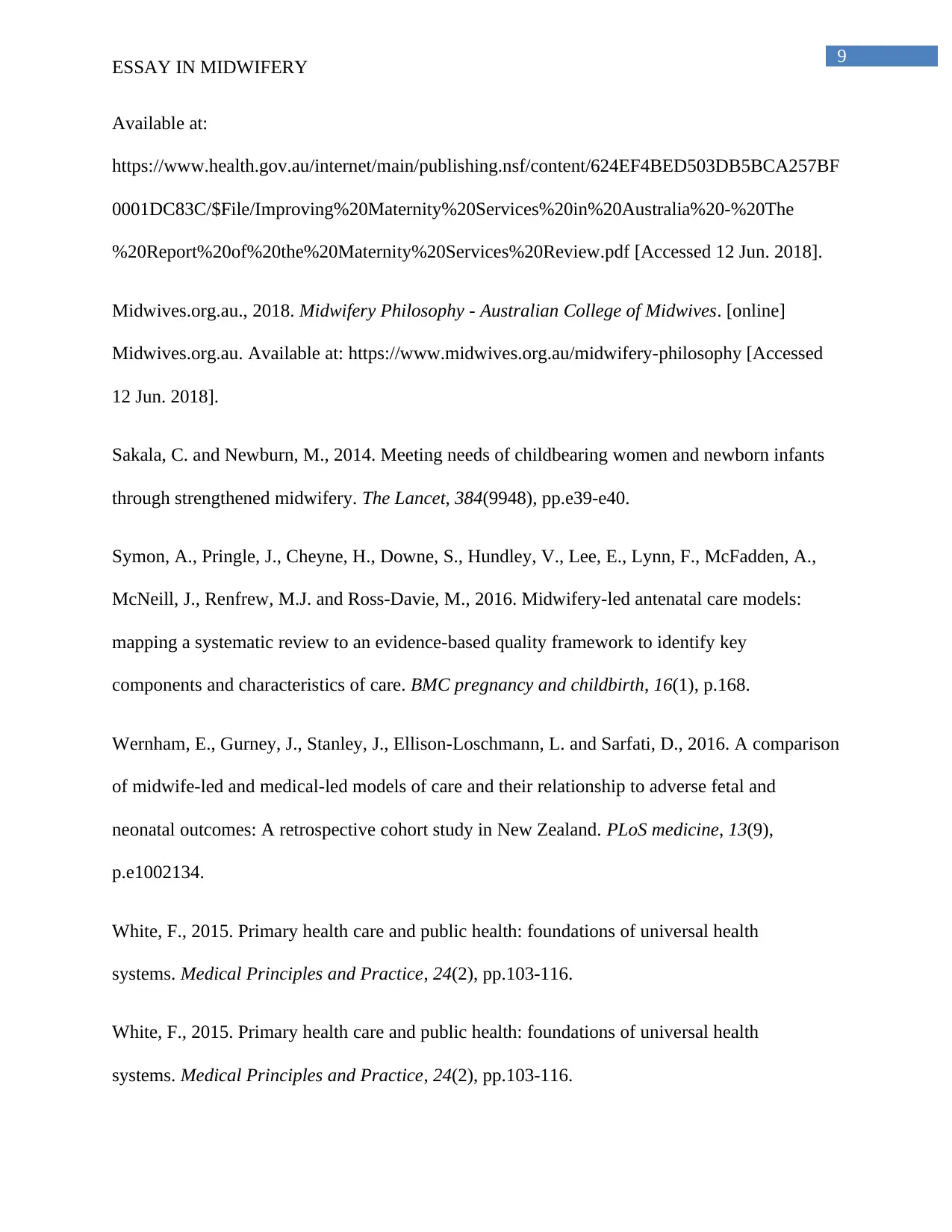
9
ESSAY IN MIDWIFERY
Available at:
https://www.health.gov.au/internet/main/publishing.nsf/content/624EF4BED503DB5BCA257BF
0001DC83C/$File/Improving%20Maternity%20Services%20in%20Australia%20-%20The
%20Report%20of%20the%20Maternity%20Services%20Review.pdf [Accessed 12 Jun. 2018].
Midwives.org.au., 2018. Midwifery Philosophy - Australian College of Midwives. [online]
Midwives.org.au. Available at: https://www.midwives.org.au/midwifery-philosophy [Accessed
12 Jun. 2018].
Sakala, C. and Newburn, M., 2014. Meeting needs of childbearing women and newborn infants
through strengthened midwifery. The Lancet, 384(9948), pp.e39-e40.
Symon, A., Pringle, J., Cheyne, H., Downe, S., Hundley, V., Lee, E., Lynn, F., McFadden, A.,
McNeill, J., Renfrew, M.J. and Ross-Davie, M., 2016. Midwifery-led antenatal care models:
mapping a systematic review to an evidence-based quality framework to identify key
components and characteristics of care. BMC pregnancy and childbirth, 16(1), p.168.
Wernham, E., Gurney, J., Stanley, J., Ellison-Loschmann, L. and Sarfati, D., 2016. A comparison
of midwife-led and medical-led models of care and their relationship to adverse fetal and
neonatal outcomes: A retrospective cohort study in New Zealand. PLoS medicine, 13(9),
p.e1002134.
White, F., 2015. Primary health care and public health: foundations of universal health
systems. Medical Principles and Practice, 24(2), pp.103-116.
White, F., 2015. Primary health care and public health: foundations of universal health
systems. Medical Principles and Practice, 24(2), pp.103-116.
ESSAY IN MIDWIFERY
Available at:
https://www.health.gov.au/internet/main/publishing.nsf/content/624EF4BED503DB5BCA257BF
0001DC83C/$File/Improving%20Maternity%20Services%20in%20Australia%20-%20The
%20Report%20of%20the%20Maternity%20Services%20Review.pdf [Accessed 12 Jun. 2018].
Midwives.org.au., 2018. Midwifery Philosophy - Australian College of Midwives. [online]
Midwives.org.au. Available at: https://www.midwives.org.au/midwifery-philosophy [Accessed
12 Jun. 2018].
Sakala, C. and Newburn, M., 2014. Meeting needs of childbearing women and newborn infants
through strengthened midwifery. The Lancet, 384(9948), pp.e39-e40.
Symon, A., Pringle, J., Cheyne, H., Downe, S., Hundley, V., Lee, E., Lynn, F., McFadden, A.,
McNeill, J., Renfrew, M.J. and Ross-Davie, M., 2016. Midwifery-led antenatal care models:
mapping a systematic review to an evidence-based quality framework to identify key
components and characteristics of care. BMC pregnancy and childbirth, 16(1), p.168.
Wernham, E., Gurney, J., Stanley, J., Ellison-Loschmann, L. and Sarfati, D., 2016. A comparison
of midwife-led and medical-led models of care and their relationship to adverse fetal and
neonatal outcomes: A retrospective cohort study in New Zealand. PLoS medicine, 13(9),
p.e1002134.
White, F., 2015. Primary health care and public health: foundations of universal health
systems. Medical Principles and Practice, 24(2), pp.103-116.
White, F., 2015. Primary health care and public health: foundations of universal health
systems. Medical Principles and Practice, 24(2), pp.103-116.
Paraphrase This Document
Need a fresh take? Get an instant paraphrase of this document with our AI Paraphraser
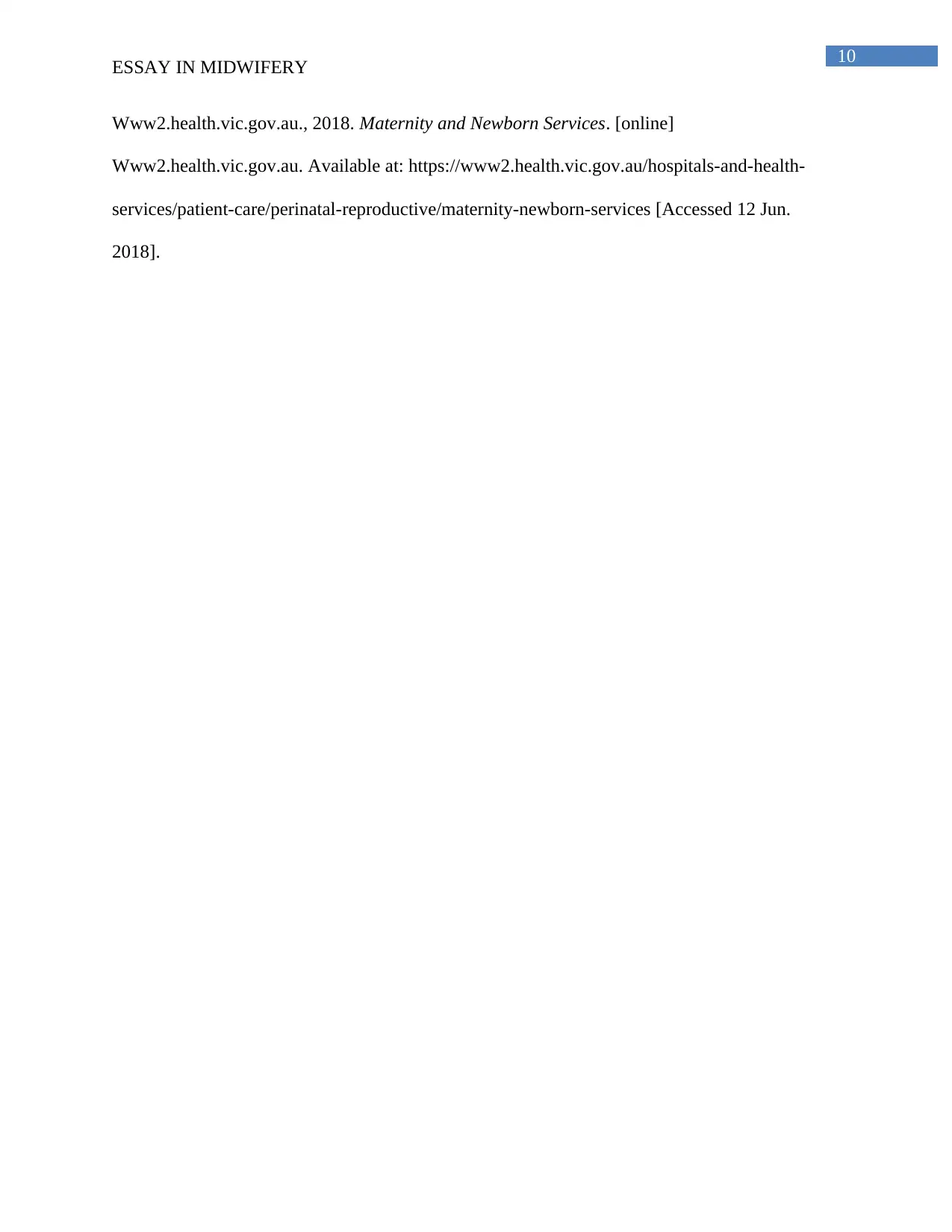
10
ESSAY IN MIDWIFERY
Www2.health.vic.gov.au., 2018. Maternity and Newborn Services. [online]
Www2.health.vic.gov.au. Available at: https://www2.health.vic.gov.au/hospitals-and-health-
services/patient-care/perinatal-reproductive/maternity-newborn-services [Accessed 12 Jun.
2018].
ESSAY IN MIDWIFERY
Www2.health.vic.gov.au., 2018. Maternity and Newborn Services. [online]
Www2.health.vic.gov.au. Available at: https://www2.health.vic.gov.au/hospitals-and-health-
services/patient-care/perinatal-reproductive/maternity-newborn-services [Accessed 12 Jun.
2018].
1 out of 11
Related Documents
Your All-in-One AI-Powered Toolkit for Academic Success.
+13062052269
info@desklib.com
Available 24*7 on WhatsApp / Email
![[object Object]](/_next/static/media/star-bottom.7253800d.svg)
Unlock your academic potential
Copyright © 2020–2025 A2Z Services. All Rights Reserved. Developed and managed by ZUCOL.





